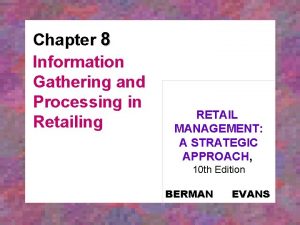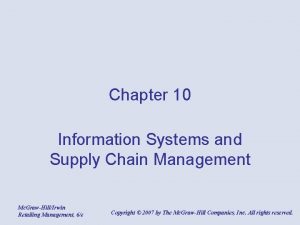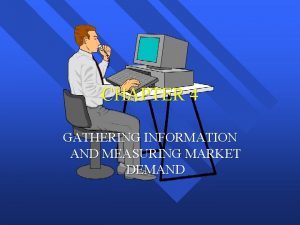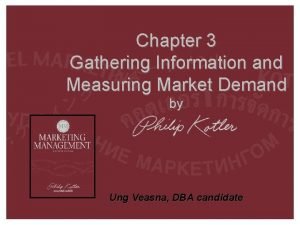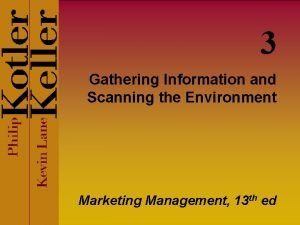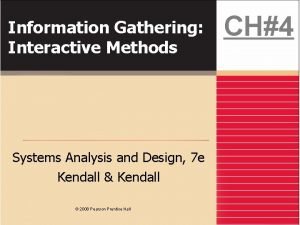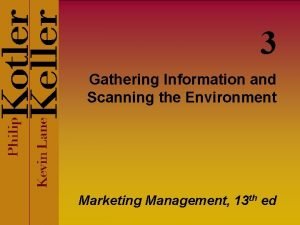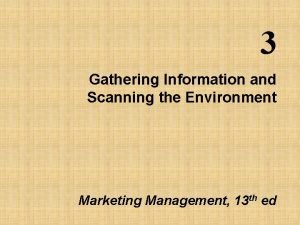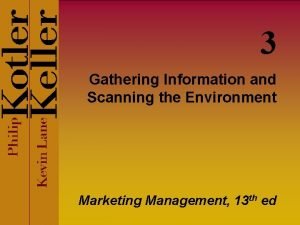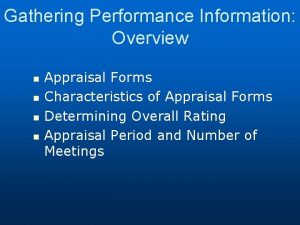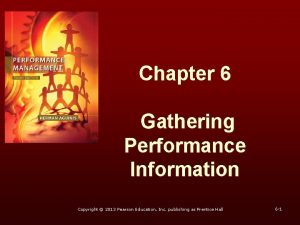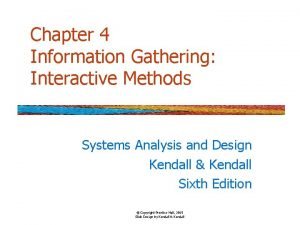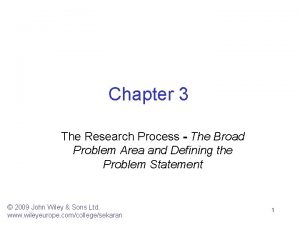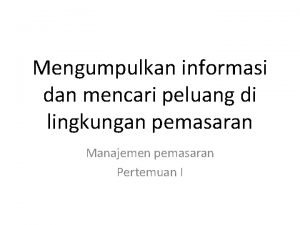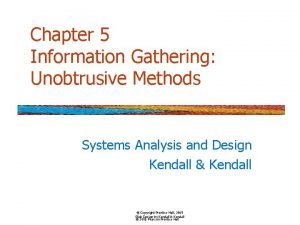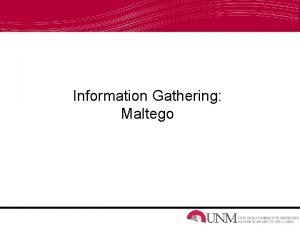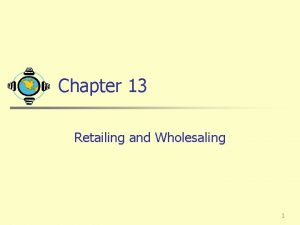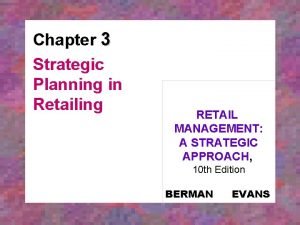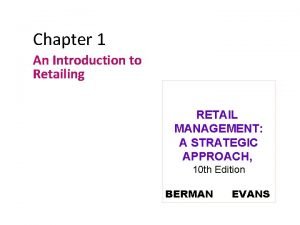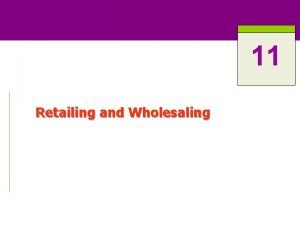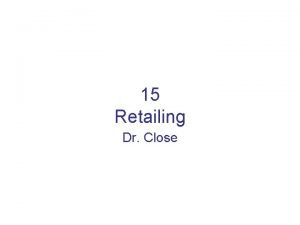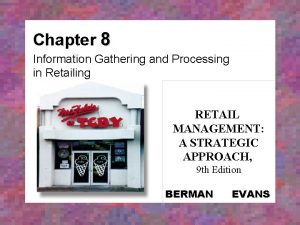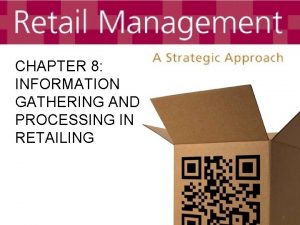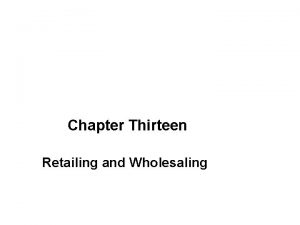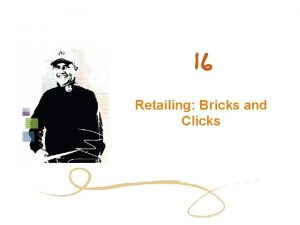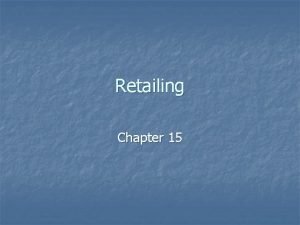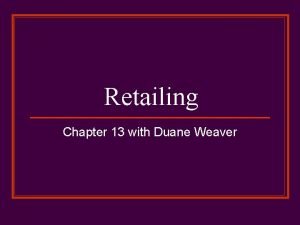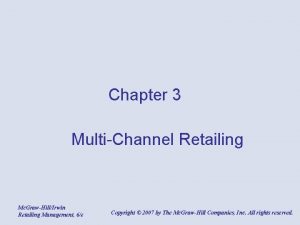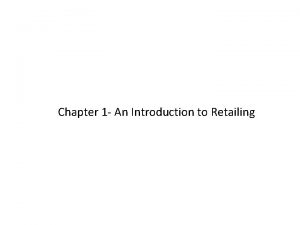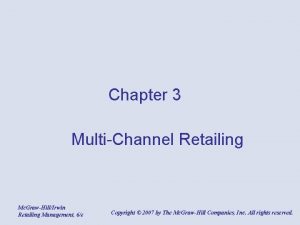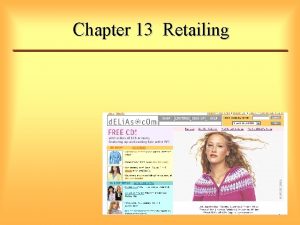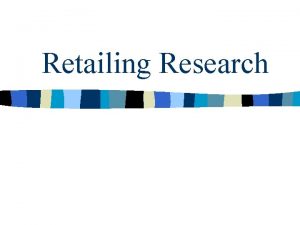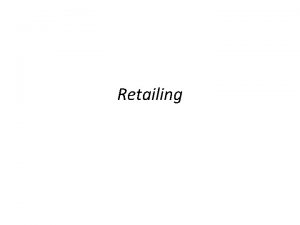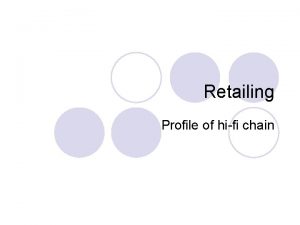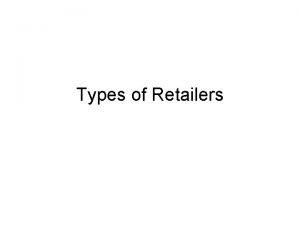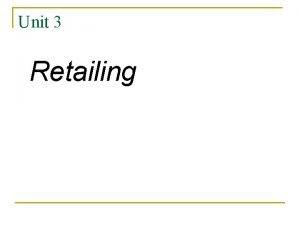Chapter 8 Information Gathering and Processing in Retailing






















- Slides: 22

Chapter 8 Information Gathering and Processing in Retailing RETAIL MANAGEMENT: A STRATEGIC APPROACH, 10 th Edition BERMAN EVANS

Chapter Objectives þ To discuss how information flows in a retail distribution channel þ To show why retailers should avoid strategies based on inadequate information þ To look at the retail information system, its components, and recent advances þ To describe the marketing research process 8 -2

Figure 8 -1: How Information Flows in a Retail Distribution Channel Information and the Supplier 8 -3 Information and the Retailer Information and the Consumer

Suppliers Need To Know From the Retailer v Estimates of category sales v Inventory turnover rates v Feedback on competitors v Level of customer returns 8 -4 From the Customer v Attitudes toward styles and models v Extent of brand loyalty v Willingness to pay a premium for superior quality

Retailers Need To Know From the Supplier v Advance notice of new models and model changes v Training materials v Sales forecasts v Justifications for price changes 8 -5 From the Customer v Why people shop there v What they like and dislike v Where else people shop

Consumers Need To Know From the Supplier v Assembly and operating instructions v Extent of warranty coverage v Where to send a complaint 8 -6 From the Retailer v Where specific merchandise is stocked in the store v Methods of payment acceptable v Rain check and other policies

Retail Information System (RIS) v Anticipates the information needs of retail managers v Collects, organizes, and stores relevant data on a continuous basis v Directs the flow of information to the proper decision makers 8 -7

Figure 8 -2: A Retail Information System 8 -8

Data-Base Management v System gathers, integrates, applies, and stores information in related subject areas v Its a major element in an RIS v Customer, vendor, product category data base v Used for – – – 8 -9 Frequent shopper programs Customer analysis Promotion evaluation Inventory planning Trading area analysis

Five Steps to Approaching Data. Base Management v Plan the particular data base and its components and determine information needs v Acquire the necessary information v Retain the information in a usable and accessible format v Update the data base regularly to reflect changing demographics, recent purchases, etc. v Analyze the data base to determine strengths and weaknesses v E. g. By customer; purchase frequency, items bought, average purchase 8 -10

Figure 8 -4: Retail Data-Base Management in Action 8 -11

Components of a Data Warehouse v Physical storage location for data – the warehouse v Software to copy original databases and transfer them to warehouse v Interactive software to allow processing of inquiries v A directory for the categories of information kept in the warehouse 8 -12

Data Mining and Micromarketing v Data mining is the in-depth analysis of information to gain specific insights about customers, product categories, vendors, and so forth v Micromarketing is an application of data mining, whereby retailers use differentiated marketing and develop focused retail strategy mixes for specific customer segments 8 -13

Figure 8 -6: Applying UPC Technology to Gain Better Information 8 -14

Figure 8 -7: The Marketing Research Process 8 -15

Marketing Research in Retailing The collection and analysis of information relating to specific issues or problems facing a retailer 8 -16

Secondary Data Advantages v Inexpensive v Fast v Several sources and perspectives v Generally credible v Provides background information 8 -17 Disadvantages v May not suit current study v May be incomplete v May be dated v May not be accurate or credible v May suffer from poor collection techniques

Secondary Data Sources Internal v Sales reports v Billing reports v Inventory records v Performance reports 8 -18 External v Government – Retail Trade – Statistical Abstract of the – Public records

Primary Data Advantages v Collected for specific purpose v Current v Relevant v Known and controlled source 8 -19 Disadvantages v May be more expensive v Tends to be more time consuming v Information may not be acquirable

Primary Data Decisions • In-house or outsource? • Sampling method? – Probability – Nonprobability • Data collection method? – – 8 -20 Survey Observation Experiment Simulation

Survey Methods v In-person v Over the telephone v By mail v Online 8 -21

Mystery Shoppers v Retailers hire people to pose as customers and observe operations from sales presentations to how well displays are maintained to service calls 8 -22
 Information gathering and processing in retailing
Information gathering and processing in retailing Information system and supply chain management in retailing
Information system and supply chain management in retailing Q=nqp
Q=nqp Marketing approach to demand measurement
Marketing approach to demand measurement Gathering information and scanning the environment
Gathering information and scanning the environment Information gathering interview
Information gathering interview Gathering information and scanning the environment
Gathering information and scanning the environment Gathering information and scanning the environment
Gathering information and scanning the environment Gathering information and scanning the environment
Gathering information and scanning the environment Types of deflation
Types of deflation Gathering performance information
Gathering performance information Information gathering: interactive methods
Information gathering: interactive methods How to create problem statement in research
How to create problem statement in research Gathering competitive information
Gathering competitive information Unobtrusive methods of information gathering
Unobtrusive methods of information gathering The action or activity of gathering information
The action or activity of gathering information Gathering background information
Gathering background information Gathering background
Gathering background What is maltego
What is maltego Chapter 13 retailing and wholesaling
Chapter 13 retailing and wholesaling It is the overall plan of action that guides a retailer.
It is the overall plan of action that guides a retailer. Retail marketing chapter 1
Retail marketing chapter 1 Unsharp masking matlab
Unsharp masking matlab
